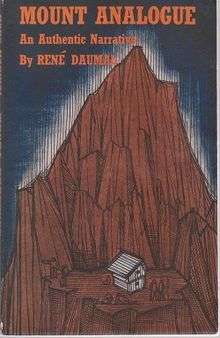Mount Analogue
 First English-language edition | |
| Author | René Daumal |
|---|---|
| Original title | Le Mont Analogue. Roman d'aventures alpines, non euclidiennes et symboliquement authentiques |
| Country | France |
| Language | French |
| Genre | fantasy |
| Publisher | Vincent Stuart Ltd. (Eng. trans.) |
Publication date | 1952 |
Published in English | 1959 |
| Media type | Print (Hardback & Paperback) |
| Pages | 106 p. (hardback edition) |
| ISBN | 0-87773-850-5 |
| OCLC | 25747666 |
| 843/.912 20 | |
| LC Class | PQ2607.A86 M613 1992 |
Mount Analogue: A Novel of Symbolically Authentic Non-Euclidean Adventures in Mountain Climbing is a classic novel by the early 20th century, French novelist René Daumal.
The novel is both bizarre and allegorical, detailing the discovery and ascent of a mountain, the Mount Analogue of the title, which can only be perceived by realising that one has travelled further in traversing it than one would by travelling in a straight line, and can only be viewed from a particular point when the sun's rays hit the earth at a certain angle.[1]
"Its summit must be inaccessible, but its base accessible to human beings as nature made them. It must be unique and it must exist geographically. The door to the invisible must be visible."
Daumal died before the novel was completed, providing an uncanny one-way quality to the journey. The leader of the expedition - "Father Sogol" is the "Logos" spelled backwards. In other words, the leader of the expedition to climb the mysterious mountain that unites Heaven and Earth is the Logos.
Mount Analogue was first published posthumously in 1952 in French as Le Mont Analogue. Roman d'aventures alpines, non euclidiennes et symboliquement authentiques.
The book was one of the sources of the cult-film The Holy Mountain by Alejandro Jodorowsky. The novel also marks the first use of the word "peradam" in literature, an object that is revealed only to those who seek it.[2]
"One finds here, very rarely in the low lying areas, more frequently as one goes farther up, a clear and extremely hard stone that is spherical and varies in size—a kind of crystal, but a curved crystal, something extraordinary and unknown on the rest of the planet. Among the French of Port-des-Singes, it is called peradam. Ivan Lapse remains puzzled by the formation and root meaning of this word. It may mean, according to him, "harder than diamond," and it is; or "father of the diamond," and they say that the diamond is in fact the product of the degeneration of the peradam by a sort of quartering of the circle or, more precisely, cubing of the sphere. Or again, the word may mean "Adam's stone," having some secret and profound connection to the original nature of man. The clarity of this stone is so great and its index of refraction so close to that of air that, despite the crystal's great density, the unaccustomed eye hardly perceives it. But to anyone who seeks it with sincere desire and true need, it reveals itself by its sudden sparkle, like that of dewdrops. The peradam is the only substance, the only material object whose value is recognized by the guides of Mount Analogue. Therefore, it is the standard of all currency, as gold is for us."
Daumal compares art and alpinism in this novel, saying:[3]
Alpinism is the art of climbing mountains by confronting the greatest dangers with the greatest prudence. Art is used here to mean the accomplishment of knowledge in action.
You cannot always stay on the summits. You have to come down again...
So what's the point? Only this: what is above knows what is below, what is below does not know what is above. While climbing, take note of all the difficulties along your path. During the descent, you will no longer see them, but you will know that they are there if you have observed carefully.
There is an art to finding your way in the lower regions by the memory of what you have seen when you were higher up. When you can no longer see, you can at least still know. . .
Some of the paintings of the Spanish-Mexican painter, Remedios Varo, were used in the illustrations for the first edition of this novel, like Embroidering the Earth's Mantle and The Ascension of Mount Analog. The Australian artist Imants Tillers created his own version of Mount Analog without having knowledge of Varo's previous work.[4]
Adaptations
- Dr. William J. Welch, a personal friend of Daumal's spiritual teacher Gurdjieff, performed a radio presentation of Mount Analogue later in his life.
- The 1973 fantasy adventure film The Holy Mountain directed by Alejandro Jodorowsky is partially based on this novel.
- Daniel Pinkwater, an American novelist, mentions Mount Analogue in his young adult book Lizard Music.
- John Zorn recorded an album of the same name inspired by the book and the teachings of Gurdjieff.
- Irish artists Walker and Walker produced a short film based on the book entitled Mount Analogue Revisited in 2010 which was used as part of a 2012 instillation in the Hugh Lane Gallery, Dublin.[5]
- German Engineer, Alpinist and Religious Scholar - Arthur von Boennighausen continued the story started by Daumal.[6]
- Ruth Ozeki mentions Mount Analogue in Appendix D of her 2013 novel A Tale for the Time Being.
References
- ↑ René Daumal, Mount Analogue: a novel of symbolically authentic non-Euclidean adventures in mountain climbing, Boston: Shambhala, 1992, p.14.
- ↑ René Daumal, "Our Money Has No Value - On the Foothills of Mount Analogue"
- ↑ René Daumal, The Art of Climbing Mountains
- ↑ "Imants TILLERS: Mount Analogue 1985", National Gallery of Australia
- ↑ , Walker and Walker
- ↑ http://www.sangre-de-cristo.com/westcliffe/analogue